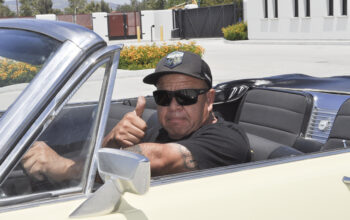
When you pick up a magazine and look through the various ads, the communication of ideas isn’t the first thing that comes to mind for a reader, but behind every graphic is an idea that an artist is trying to convey.
Richard Kamimura, who teaches graphic design and typography, prepares Pierce students for a future in the industry of graphic design by sharing what he has learned.
“I’ve always been pretty excited and interested in design itself,” Kamimura said. “Telling a story through the graphics you present.”
Storytelling, or the conveying of ideas, is normally thought of as a medium more likely used by painters, photographers and authors, but through the use of typography, space, color and visual elements like photos, and all aspects found and used in other fields of art, graphic design can also communicate.
“My original background was in illustration but the concepts themselves carry across,” Kamimura said. “So composition, bringing your view to a specific hierarchy; these are all the same concepts that carry across from various art forms to design.”
Kamimura received his masters in digital and traditional illustration from Cal. State Fullerton and has been teaching what he learned there as well as what he learned from his professional experience for 9 years.
“I was familiar with the program [at Fullerton] and the instructors there were really amazing,” Kamimura said. “Financially it was a lot better to go to Cal. State Fullerton than it would be to go to USC, UCLA, and at the time I just got married and a lot of financial burdens, but it was mainly the culture and the instruction that I knew I would get from Cal. State Fullerton.”
The culture of creativity and community is what helps students build their artistic skills, and it is that sense of culture Kamimura experienced at Fullerton that he instills in his students at Pierce.
“My first projects within all my classes tend to link students together so it builds a culture and connection with each other,” Kamimura said. “Once I develop that culture, it automatically creates that bridge.”
While building a culture of creativity certainly helps students hone in on their artistic skills, it can be trickier to get students to feel comfortable with telling a story through design.
“A lot of people have that nervous feeling of ‘Oh, I have to write a specific thing and it has to make sense,'” Kamimura said. “So I tackle that fear by incorporating shape design and utilize fonts as actual design itself versus having to say a specific thing, and that usually gets students excited about design because now you can visually create stuff, manipulate images and build a good compositional design along with typography.”
25-year-old graphic design major Ben Quintero thinks Kamimura’s hands-on approach to teaching graphic design will help him as he pursues a future in the industry.
“I’ve been doing some graphic design for 3 years now and I want to get into advertising, creating logos and all that,” Quintero said. “I’ve had other graphic design instructors, but he seems more hands-on than the others I’ve had where they’ll give you the work and you do your own thing.”
The transition from student to professional could be a challenge for any new graduate but Kamimura imparts some wisdom from his transitional experience after his time in Cal. State Fullerton.
“Initially it was a little nerve-wracking, because as a brand new grad you have all these things you’re worried about, industry-wise,” Kamimura said. “But my experience was really good because I started with an internship that was for 2 to 3 weeks, but what I did was make an effort to get my hands in all the projects so that [internship] turned to 2 or 3 years.”
For 21-year-old Liat Halmos, a student of Kamimura’s as well as a design major, freelancing design jobs is her current path to the industry.
“It’s a pretty popular field nowadays,” Halmos said. “I like to work in the music industry, do album covers and festival posters. I’ve been doing a lot of freelancing so we’ll see where it takes me.”
Despite the uncertainty that some students may feel about their futures in the graphic design industry, Kamimura is optimistic about Pierce students becoming future designers.
“The students here at Pierce are awesome,” Kamimura said. “It’s a very exciting situation here because they have that willingness to learn and really develop themselves.”



